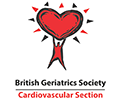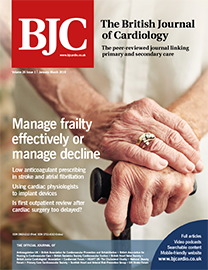Editorials
Clinical articles
News and views
Topics include:-
- Manage frailty effectively or manage decline
- Low anticoagulant prescribing in stroke and atrial fribrillation
- Using cardiac physiologists to implant devices
- Is first outpatient review after cardiac surgery too delayed?

February 2019 Br J Cardiol 2019;26:8–9 doi:10.5837/bjc.2019.010
Tess Harris, Umar Chaudhry, Charlotte Wahlich
Abstract

It is widely known that physical activity provides strong physical, psychological and cognitive health benefits, with over 20 different conditions showing prevention and treatment effects,1 including mortality reductions comparable with drug treatments in heart failure and stroke.2 Economic effects are important, with physical inactivity responsible for approximately 13.4 million disability-adjusted life-years worldwide, over $100 billion in healthcare expenditure in the US,3 and £0.9 billion in the UK,1 annually. Yet, despite this, around 40% of UK adults report being insufficiently active for health, worse with increasing age and socio-economic deprivation.1 Objectively measured findings are much worse, only 5% achieve guidelines by accelerometry, compared to 50% by self-report.4
|
Full text

January 2019 Br J Cardiol 2019;26(1) doi:10.5837/bjc.2019.001
Srikanth Bellary, Alan J Sinclair
Abstract

Over the last few decades there has been a steady increase in life-expectancy leading to an increase in the ageing population, placing significant demands on health and social care.1 Among the several healthcare issues that confront older people, frailty has emerged as an important entity, and tackling frailty has assumed greater significance.2 There is currently no single agreed definition of frailty, but it is widely accepted as a condition characterised by reduced response to stressors consequent to decline in multiple physiological systems associated with ageing. Prevalence of frailty in community-dwelling older adults is estimated to be around 10–14%, but figures between 4% and 49% have been quoted in various populations.3,4 Prevalence also varies with age, with around 7% in adults over 65 years, increasing up to 25% in those aged 80 years and above.5 There are a number of tools to detect frailty, and the most commonly used tool is the criteria proposed by Fried and colleagues based on data from the Cardiovascular Health Study, which assesses five domains, namely weight loss (≥5% weight loss in the past year), exhaustion (effort required for activities), slow walking speed (>6–7 s per 15 feet), weakness as measured by grip strength and decreased physical activity (kilocalories/week: male <383, female <270), with the presence of three or more of these fulfilling the criteria for frailty.5
|
Full text
Clinical articles
Back to top

February 2019 Br J Cardiol 2019;26:23–6 doi:10.5837/bjc.2019.007
Calum Creaney, Karissa Barkat, Christopher Durey, Susan Gallagher, Linda Campbell, Ashish MacAden, Paul Findlay, Gordon F Rushworth, Stephen J Leslie
Abstract

Atrial fibrillation (AF) increases stroke risk fivefold. Oral anticoagulation (OAC) with warfarin reduces the risk of stroke by 64%. Direct oral anticoagulants are non-inferior to warfarin in preventing stroke in non-valvular AF, but have a lower risk of fatal intracranial haemorrhage. We determined how many patients discharged with a diagnosis of ischaemic stroke and AF were prescribed OAC, and established reasons for, and associations with, non-prescription of OAC.
All patients discharged with a diagnosis of ischaemic stroke and AF during the four-year period between 2013 and 2016 within NHS Highland were included in the study. Patients who started OAC after a period of treatment with antiplatelets were considered as being treated with OAC. Electronic patient records provided demographics, CHA2DS2-VASc and HAS-BLED scores and information on why patients were not started on OAC.
A total of 181 patients were discharged with a diagnosis of ischaemic stroke and AF over the study period: 52.5% (n=95) were female (p=0.45); 35.4% (n=64) were discharged without OAC. The median CHA2DS2-VASc score for patients not treated with OAC was 5 (interquartile range [IQR] 4–6). The median HAS-BLED score was 3 (IQR 2.5–4). There was no difference in rate of OAC prescription between men and women (67% vs. 62%, p=0.45). Patients 80 years of age or older were significantly less likely to be prescribed OAC on discharge than those under 80 years (54% vs. 76%, p=0.002). The two most common reasons for withholding OAC were concern over bleeding risk and falls. Patients treated at a hospital with a stroke unit were no more likely to be discharged on OAC compared with those treated at hospitals without a stroke unit (66% vs. 62%, p=0.64). Of patients not treated with OAC, 64% (n=41) were discharged on long-term antiplatelet drugs.
In conclusion, raising awareness of the relatively low risk of major bleeding, even in elderly patients and in those at risk of falls, might help increase OAC usage and reduce recurrent strokes.
|
Full text
February 2019 Br J Cardiol 2019;26:34 doi:10.5837/bjc.2019.008
Dumbor L Ngaage, Michael R Gooseman, Kerry L Bulliment, Martin A Jarvis, Mubarak A Chaudhry, Alexander R Cale, Michael E Cowen
Abstract

The traditional practice of conducting the first outpatient review six weeks after cardiac surgery is not evidence-based. This study was designed to determine mortality and morbidity in the interval between hospital discharge and the first outpatient follow-up.
We enrolled patients undergoing non-emergency cardiac surgery from June 2016 to May 2017 into this prospective observational study. Prior to hospital discharge, patients were consented and given a questionnaire to document attendance at any healthcare facility. Ethical approval was obtained from the Health Research Authority.
The mean age of the 72 study patients was 68 ± 4 years. The majority underwent coronary artery bypass grafting (56.9%). The six-week postoperative morbidity rate was 38.9% and hospital readmission 15.3%. Morbidity, highest in the first week after discharge, declined to its lowest level by four weeks. Surgical site (13.9%) and respiratory complications (13.9%) were predominant causes of late morbidity. There was no mortality. Most patients (50%) expressed satisfaction with current practice, but a significant number (44.4%) would prefer earlier review.
In conclusion, morbidity during the six-week wait for the first outpatient review after cardiac surgery is not insignificant, but declines over time. Current practice does not seem to enable a positive specialist influence of the post-surgery recovery pathway.
Clinical Trials.gov registration number: NCT02832427
|
Full text

February 2019 Br J Cardiol 2019;26:31–3 doi:10.5837/bjc.2019.009
Mark T Mills
Abstract

Anti-arrhythmic drugs and pulmonary vein isolation (with radiofrequency ablation) are established treatment options in the management of atrial fibrillation. Both methods have their advantages and drawbacks. Atrial fibrillation is the consequence of complex systemic and atrial factors, resulting in atrial remodelling. Emerging treatment strategies that target and reverse atrial remodelling may offer a promising alternative to anti-arrhythmics and ablation.
|
Full text
February 2019 Br J Cardiol 2019;26:38–40 doi:10.5837/bjc.2019.011
Anthony Brennan, Heath Adams, John Galligan, Robert Whitbourn
Abstract

Takotsubo cardiomyopathy (TTC) is characterised by transient left ventricular dysfunction accompanied by apical ballooning of the ventricle. Takotsubo pathophysiology is poorly understood and is often triggered by an emotional or physical stressor. This is a case of a 71-year-old woman who presented with sudden-onset exertional chest pain leading to inferior ST-elevation on electrocardiography (ECG) with a significant troponin rise. Immediate coronary angiography revealed a severe mid-posterior left ventricular (PLV) branch of the right coronary artery stenosis. The left coronary system was normal. Left ventriculogram revealed mid-to-apical ballooning typical of TTC. Considering the disconnect between the coronary and ventriculogram findings, a decision was made to delay percutaneous coronary intervention (PCI). The patient was treated with heart failure medications and symptoms improved. Repeat angiogram of the mid-PLV after a short period of medical therapy revealed no coronary lesion and the left ventricular function had normalised. These findings suggest that coronary artery vasospasm may have contributed to the aetiology in this case of TTC. This case adds weight to previous theories of an interplay between TTC and coronary vasospasm.
|
Full text

January 2019 Br J Cardiol 2019;26:14–8 doi:10.5837/bjc.2019.002
George Collins, Sarah Hamill, Catherine Laventure, Stuart Newell, Brian Gordon
Abstract

Movement restrictions are given to patients after cardiac rhythm device implantation, despite little consensus, or evidence that they reduce complications. We conducted a UK survey assessing the nature of the advice and if it varies between individuals and institutions. A survey was distributed to cardiac rhythm teams at UK implanting centres. Questions concerned the advice that is given, its source, and who is responsible for providing it.
There were 100 responses from 42 centres. Advice is given by physiologists, nurses, and cardiologists. Advice comes from local protocols, information leaflets, current hospital opinion, manufacturers, national leaflets, published research and audit data. Within and between centres there was little agreement on what the advice should be. Depending on who gives the advice, a number of leisure pursuits were either completely unrestricted or restricted indefinitely. Cardiologists were less restrictive than others.
In conclusion, this is the first UK survey to assess the movement and mobilisation advice given to patients after device implantation. There is variation in the source and nature of advice. Over-restriction could impact on patients’ quality of life. Contradictory advice could cause uncertainty. Further work should determine the impact of this variation and how the effects could be safely mitigated.
|
Full text
January 2019 Br J Cardiol 2019;26:19–22 doi:10.5837/bjc.2019.003
Varun Sharnam, Stelios Iacovides, Luisa Cleverdon, Wasing Taggu, Philip Keeling
Abstract

Implantable cardiac monitors (ICMs), also known as implantable loop recorders (ILRs), are used for long-term heart rhythm monitoring of unexplained syncope or in the detection of arrhythmias. These devices are implanted by cardiologists within a cardiac catheter suite environment. The newer generation devices are miniaturised and inserted using a specific tool kit via a minimally invasive procedure. This paper describes the changes we have made to allow these devices to be implanted in a non-theatre environment by a cardiac physiologist and the benefits and cost reduction of this service redesign.
A cardiac physiologist (LC, Band 6) undertook specific training beginning in September 2015. A standard operating procedure (SOP) was developed and patient information videos were commissioned. The new service was introduced in September 2016 in the screening room of our critical care unit (CCU). Data were collected prospectively on the clinical outcome, patient satisfaction and costs.
Over a 13-month period LC independently performed 116 procedures (113 Medtronic Reveal LINQ™ ICMs and 3 St. Judes SJM CONFIRM™) with only one minor complication. Patients were highly satisfied with the redesigned service, which showed a reduction in cost of £241.27 per case.
ICMs/ILRs can be implanted safely and cost-effectively outside a cardiac catheter suite environment by a cardiac physiologist. This requires some specific training, a clinical SOP and is supported by use of dedicated patient information videos.
|
Full text
January 2019 Br J Cardiol 2019;26:27–30 doi:10.5837/bjc.2019.004
Alexander J Gibbs, Andrew Potter
Abstract

Previous research estimates that up to 40% of palpitation presentations to the emergency department (ED) have cardiac aetiology. This study was performed to determine the proportion of patients referred on for cardiology investigations that consequentially had new significant pathology diagnosed; and the effect of follow-up investigation on patient re-attendance to the ED with the complaint of palpitations.
Patients referred to a community cardiology centre in 2016 for investigation into palpitations following an ED presentation were included. The diagnosis that each patient received from these investigations was analysed to see whether: (a) new underlying cardiac abnormality was identified and (b) that abnormality was significant, requiring follow-up.
There were 93 patients meeting criteria for analysis: 28% had a cardiac cause for their palpitations elicited, including 11% with new significant pathology identified. Rate of re-attendance to the ED was reduced once cardiology investigations were completed (0.11 presentations/patient; 95% confidence interval [CI] 0.04 to 0.18) compared with the investigation period (0.75 presentations/patient; 95%CI 0.3 to 1.2).
In conclusion, although only one tenth of patients referred for investigations had new significant cardiac pathology identified, completing cardiology investigations reduced ED re-attendance.
|
Full text
January 2019 Br J Cardiol 2019;26:35 doi:10.5837/bjc.2019.005
Pramod Kumar Kuchulakanti, VCS Srinivasarao Bandaru, Anurag Kuchulakanti, Tallapaneni Lakshumaiah, Mehul Rathod, Rajeev Khare, Parsa Sairam, Poondru Rohit Reddy, Athuluri Ravikanth, Avvaru Guruprakash, Regalla Prasada Reddy, Banda Balaraju
Abstract

Recent studies have associated subclinical hypothyroidism with heart failure (HF) and increased mortality. To investigate the relationship between subclinical hypothyroidism and HF in Indian patients we prospectively recruited 350 HF patients between March 2013 and February 2017 at the department of cardiology Yashoda Hospital, Hyderabad, India. All patients underwent fasting serum glucose, lipid profile, N-terminal-pro-brain natriuretic peptide (NT-proBNP), and thyroid hormone levels. Risk factors and clinical evaluation were undertaken. We divided thyroid-stimulating hormone (TSH) levels into severity grade 1 (≤9.9 mIU/L) and grade 2 (≥10 mIU/L).
Out of 350 HF patients, 191 (54.5%) were men, mean age was 60.4 ± 10.2 years (range 36–85 years). The incidence of subclinical hypothyroidism was 18.5%, 69.4% had normal thyroid function, and 12% had overt hypothyroidism. Mean NT-proBNP levels were 3561 ± 5553 pg/mL and 10.5% suffered in-hospital mortality. Dyslipidaemia (p=0.004), elevated NT-proBNP levels (p<0.0001) and mortality (p<0.0001) were significantly associated with subclinical hypothyroidism compared with euthyroidism. After multi-variate analysis, hypertension (odds ratio [OR] 3.5; 95% confidence interval [CI] 2.32, 3.8), dyslipidaemia (OR 1.7; 95%CI 1.12, 2.8), subclinical hypothyroidism (OR 1.39; 95%CI 0.99, 1.82) and NT-proBNP >600 pg/mL (OR 1.98; 95%CI 1.23, 2.04) were significantly associated with HF. Grade 2 TSH (OR 4.16; 95%CI 2.04, 8.48), elevated NT-proBNP >1800 pg/mL (OR 2.18; 95%CI 1.53, 4.82), and severe left ventricular dysfunction (OR 2.51; 95%CI 1.24, 2.07) were significantly associated with poor outcome.
In conclusion, our study has established that subclinical hypothyroidism is associated with HF and grade 2 TSH has an independent association with in-hospital mortality in Indian patients.
|
Full text
January 2019 Br J Cardiol 2019;26:36–7 doi:10.5837/bjc.2019.006
Lal H Mughal, Andrew R Houghton, Jeffrey Khoo
Abstract

Ivabradine is an I(f)-channel blocker currently used for the treatment of angina and heart failure. Although these channels are known to be found within the sino-atrial node, recent studies have also found localisation within the ventricular myocardium, and there have been reports of ventricular arrhythmia suppression in animal models. We describe an unusual case of significant ventricular ectopy suppression in a patient with non-ischaemic dilated cardiomyopathy. This was accompanied by a significant improvement in percentage pacing from her cardiac resynchronisation device, with corresponding improvement in her functional status. This report suggests, first, that the morbidity and mortality benefit of ivabradine in heart failure may not be solely due to its sino-atrial heart-rate lowering effect, and, second, highlights a potential role for ivabradine in the management of ventricular arrhythmias, which requires further studies to substantiate.
|
Full text
News and views
Back to top

February 2019 Br J Cardiol 2019;26:9
On behalf of the Committee of the British Geriatrics Society Cardiovascular Section (BGS CV Section), we are delighted to announce that the British Journal...
February 2019 Br J Cardiol 2019;26:10
Lewisham and Greenwich NHS Trust is the first NHS Trust in the country to offer video consultations for cardiology patients so they get...
February 2019 Br J Cardiol 2019;26:10
Data were recently presented on a new drug class, precision oral anticoagulants (PROACs) at the recent International Stroke Conference 2019, organised by the...
February 2019 Br J Cardiol 2019;26:10
The first nationally agreed guidelines on the safe practice of total intravenous anaesthesia (TIVA) have been produced by The Association of Anaesthetists and...
February 2019 Br J Cardiol 2019;26:10
A recent randomised, controlled pilot study has shown significant stabilisation of the cardiovascular system in patients suffering from septic shock when treated with...
February 2019 Br J Cardiol 2019;26:12
...
December 2018
This year’s fascinating and thought-provoking 13th Annual Scientific Meeting of the Cardiorenal Forum brought together experts from the closely linked specialties of nephrology, cardiology...








